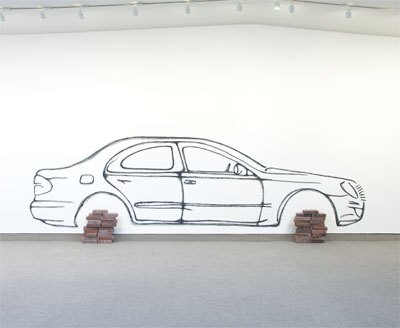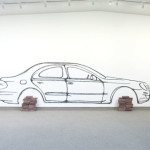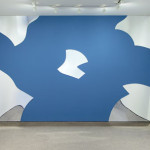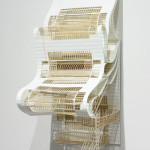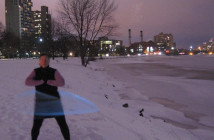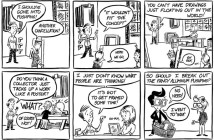MISSING @ BARBARA KRAKOW GALLERY
"Less is more" is the aesthetic motto that ties this group of diverse artists together.... In a world bombarded by visual imagery, this exhibition powerfully articulates a great deal of information in an uncomplicated manner. A pervading missing link formulates an atmosphere of inexplicit absence that questions the significance of society's continuous search for concrete explanations. Set in a pristine white space on Newbury Street is a miniature museum-like exhibition at Barbara Krakow Gallery, featuring the work of international stars ranging from Michelangelo Pistoletto to Sol LeWitt.
The title "Missing" provides the viewer a tool to conceptually approach the entire exhibition. Though lighthearted at first glance, thought provoking metaphors leave you feeling slightly on edge. Though perhaps most importantly, this show lent itself to question the complex nature of contemporary art itself. The artists present eminent issues concerning the following concepts: the hand of the artist, tangible mediums, art as idea, ownership, definable subject matter, nontraditional methods of display, notions of impermanence, and site specificity -- all very ambitious tasks for any gallery whose underlying motive is to gain profit in a retail-driven artistic environment.
Upon entering the show, the viewer encounters a substantial wall drawing Car on Bricks (2008), by the South African artist, Robin Rhode. This piece depicts a simple yet distinctive outline of a sedan that initially appears amiable; however, the ethereal portrayal is incomplete and disconcerting - missing, are the wheels, which are replaced by immobile stacks of masonry bricks. The interaction between what is real and illusory is a common premise for Rhode's artwork. This piece evokes earlier work where the artist himself interacts with his drawings as if they physically existed -- this opposition creates a strong duality to ponder.
According to the wall text, this piece is limited to fifteen installations with relatively similar dimensions. But what exactly does that mean for the serious contemporary art collector? If you have the financial means to purchase the piece at fifteen grand, then you might be interested in exactly what you go home with. Clearly this artwork would be impossible to transport, as it is bound to the wall it is created on—therefore, what you will receive is a signed and numbered certificate, including information on how it should be installed. And the process of turning the idea into its visual constituent comes at a cost—additionally you will need to hire someone (not the artist) to create it for you.
It is not uncommon for the artist to play a minimal or completely absent role in the actual assembly and making of his/her art. Take for example the legendary wall drawings of Sol LeWitt who is frequently credited for transforming the relationship between the idea and the art object. LeWitt is a principal proponent of using assistants and directive methods for completing his concepts, which has now become a commonplace artistic practice to execute large-scale ideas. His piece at Barbra Krakow is just a taste of this method. Counteracting the artist's intricate and obsessive wall drawing, is another much simpler piece by Sol LeWitt entitled Horizontal Lines, Black and Gray (2004). This relatively small gouache on paper is particularly intriguing because the artist created it completely by his own hand.
The entire show brings to mind 1960's Minimalism- a movement that is recognized by work that is stripped down to its pure and fundamental features. These artists are utilizing this style as an aesthetic or conceptual reference point to search for an innovative ways to organize visual information. A defining constituent of these post-minimal artists in the show is the absence of color. It is immediately evident that the majority of the works are black & white, monochromatic neutrals, or their offspring of gray -- all colors pertaining to absence. With the exception of Pistoletto's vivid blue wall, this intentional deficiency strips the viewer away from the automatic emotional responses associated with color, to focus solely on the art at hand.
Fred Sandback's Untitled (1976) etchings exemplify this minimalistic tendency. Each print in his four part series depicts a pair of straight black lines that would eventually intersect if they were to extend further -- as has resulted in the final one. These twin lines profoundly relate to our relationships in space and the inevitable collisions that occur in life.
Allan McCollum's monotonous frames display the complete absence of an image. His Collection of Ten Plaster Surrogates (1982/92) is reminiscent of Ad Reinhardt's infamous solid black paintings. These ten rectangular pictures stand as placeholders for what might be. As a set, the frames are displayed in a crowded arrangement that is suggestive of family photos in the hallway of a home; however the central image is completely black. Each piece is subtly unique due to the slight variations in the plaster, yet they overtly contradict the idea of a traditional painting and make the viewer rethink his understanding of art. These neutral generic forms encourage thoughts about the societal forces that give paintings meaning, more than the actual painting itself. McCollum is concerned with the relationship between art and mass production. Interestingly however, these purposefully mundane renderings meant to critique capitalistic consumption and value, are ironically amongst the most highly priced objects at the gallery.
Songs Without Words (2008) is, for Joseph Grigely, literately just that. After learning that the artist is completely unable to hear, this piece becomes particularly intriguing and powerful. Grigely explores the difficulties in interpretation between seeing and hearing. The set of twelve black and white printed newspaper clippings from musical performances draw awareness to the lyrical bodily gestures and emotional facial expressions of the voiceless musicians. The notion of understanding music through visual sources opens up a new way of thinking about sound through a point of view similar to that of the deaf.
Slightly more difficult to place, was the work by the Italian artist, Michelangelo Pistoletto. His piece Affresco- 5 (1998), contained five large mirror fragments that distort the viewer and interact with the negative space on a vibrant blue wall. Even though the simplistic affinities were consistent with the exhibition, the bright color and unavoidable funhouse interaction proved otherwise. Like Rhode's wall work, this piece comes as a signed and numbered collaged certificate.
Lastly, in the adjacent room is work by Josiah McElheny, a glass artist who is known for his mirrored boxes that contain reflective vases that seem to extend infinitely into space. His White Modernism (2008) complements his sculptural work nicely. Displayed is a framed portfolio of thirteen eloquent iridescent prints. The ghostly white on white images can only be seen from specific angles under distinct lighting conditions. When properly positioned, you are reveled sensuous shapes that inspire his sculptures. Echoing the intentions of the exhibition, the opening page begins with a quote by Adolf Loos "the evolution of culture is synonymous with the removal of ornamentation from objects of everyday use."
Leaving the viewer to fill in the gaps... what is "Missing" has been found! These pieces can only be completed with the thoughts of the beholder -- You.
- Robin Rhode, Car on bricks, Wall drawing and bricks, 2008.
- Michelangelo Pistoletto, Affresco – 5, Michelangelo Pistoletto Affresco – 5, 1998 Five acrylic mirror fragments mounted on a painted wall, 1998
- Sarah Sze, Notepad, Offset color lithography, laser engraved paper & board and thumbtack, 2008
"Missing" is on view until March 4 at Barbara Krakow Gallery.
All images are courtesy of the artist and Barbara Krakow Gallery.

